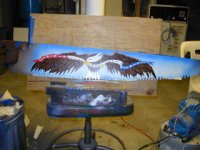Some will advocate "blast-em" with a power washer, but I would wash the door with a solution of TSP, using the box directions for painted surfaces. Use a brush, and rinse thoroughly. This will remove any chalking of the paint. Let it dry completely. I would avoid chemicals, especially the two you mentioned since they are fairly "hot" and would probably dissolve the old paint and primer (they are primary ingredients in many paint strippers). Paint recoat failures on these doors will occur primarily from failure to remove dirt, dust, and chalky paint before recoating.
There are two hard parts to reach on these sectional doors, the seams and the areas behind the weatherstrips on the sides and top. Depending on the assembly of your garage, it may be simple to pry off the weatherstrip (if wood), or unscrew it (if metal). The very top of the door does not need its' weatherstrip removed since you can get at that area from inside the garage when the door is partly opened. If you don't want to dissassemble the weatherstrips, you can also reach the side portions of the door from the inside of the garage when the door is open.
The seams can be painted from the outside as each panel "breaks" to go up the top of the track. Don't be complulsive and try to paint every bit of the seam, just get the outside portion of the tongue and groove. Keep the paint layer thin so you don't get large drops of paint "glueing" the panels together when closed.
Check the back of the door for a label that describes paint requirements, if any. For example, some exterior doors require latex paint. If none, either oil or latex will work over properly cleaned and prepared surface.
The smoothest finish will come with oil based paint with a flow-controller such as Penetrol added. This lets the paint lay out and flow better. It's a pain to clean up, however.
Latex has the theoretical advantage of being more "flexible" and would suffer less from movement, vibration, and dings.
I would use a high quality latex paint, using a roller to cover broad areas, and a 3" angle brush to get into and clean up the raised panel/corners. Again, I would recommend a flow-control agent such as Floetrol to extend the working time of the latex and decrease brush marks. The secret to latex is to lay it out and not play with it too much.
Spraying sounds like an interesting option, but I have no experience with this. It always seemed like I would spend more time cleaning up the equipment than I would painting. I'm sure somebody will chime in for spraying.
